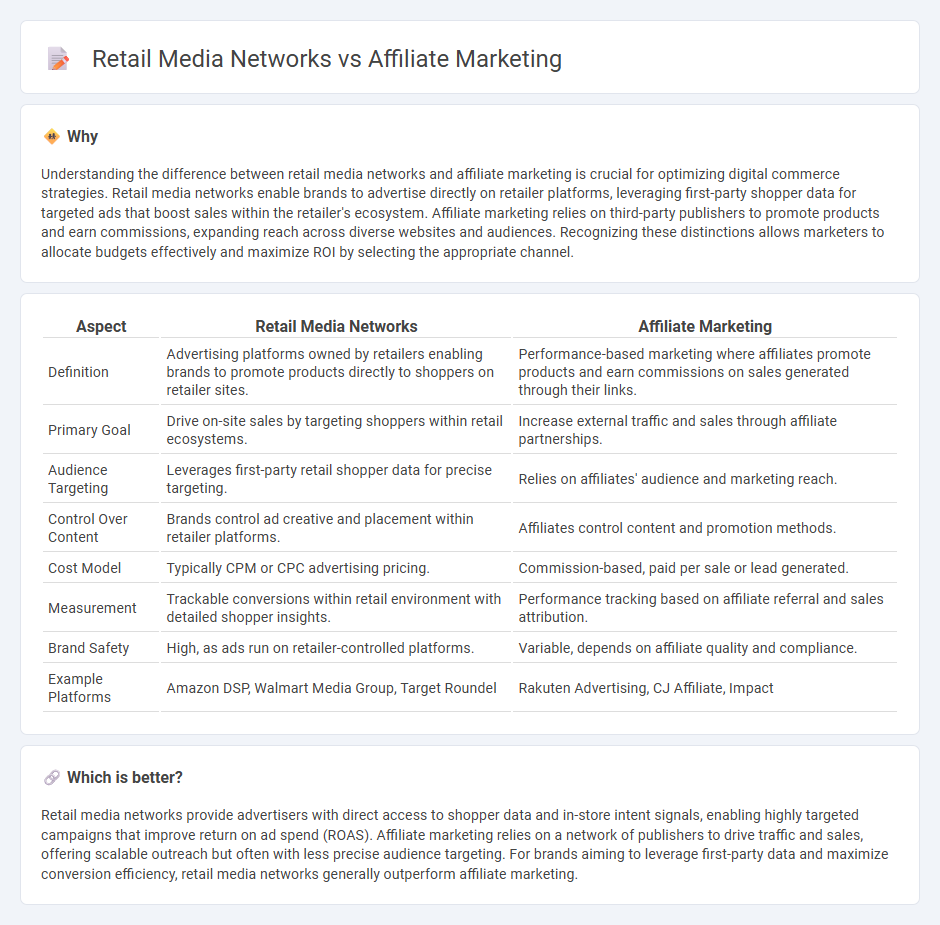
Retail media networks harness first-party shopper data to deliver targeted advertising directly on retailer platforms, enhancing consumer engagement and driving sales. Affiliate marketing relies on third-party publishers to promote products through tracked links, rewarding commissions based on performance metrics like clicks or conversions. Explore the benefits and strategic applications of retail media networks compared to affiliate marketing to optimize your commerce efforts.
Why it is important
Understanding the difference between retail media networks and affiliate marketing is crucial for optimizing digital commerce strategies. Retail media networks enable brands to advertise directly on retailer platforms, leveraging first-party shopper data for targeted ads that boost sales within the retailer's ecosystem. Affiliate marketing relies on third-party publishers to promote products and earn commissions, expanding reach across diverse websites and audiences. Recognizing these distinctions allows marketers to allocate budgets effectively and maximize ROI by selecting the appropriate channel.
Comparison Table
| Aspect | Retail Media Networks | Affiliate Marketing |
|---|---|---|
| Definition | Advertising platforms owned by retailers enabling brands to promote products directly to shoppers on retailer sites. | Performance-based marketing where affiliates promote products and earn commissions on sales generated through their links. |
| Primary Goal | Drive on-site sales by targeting shoppers within retail ecosystems. | Increase external traffic and sales through affiliate partnerships. |
| Audience Targeting | Leverages first-party retail shopper data for precise targeting. | Relies on affiliates' audience and marketing reach. |
| Control Over Content | Brands control ad creative and placement within retailer platforms. | Affiliates control content and promotion methods. |
| Cost Model | Typically CPM or CPC advertising pricing. | Commission-based, paid per sale or lead generated. |
| Measurement | Trackable conversions within retail environment with detailed shopper insights. | Performance tracking based on affiliate referral and sales attribution. |
| Brand Safety | High, as ads run on retailer-controlled platforms. | Variable, depends on affiliate quality and compliance. |
| Example Platforms | Amazon DSP, Walmart Media Group, Target Roundel | Rakuten Advertising, CJ Affiliate, Impact |
Which is better?
Retail media networks provide advertisers with direct access to shopper data and in-store intent signals, enabling highly targeted campaigns that improve return on ad spend (ROAS). Affiliate marketing relies on a network of publishers to drive traffic and sales, offering scalable outreach but often with less precise audience targeting. For brands aiming to leverage first-party data and maximize conversion efficiency, retail media networks generally outperform affiliate marketing.
Connection
Retail media networks leverage the digital platforms of retailers to display targeted advertisements, directly influencing consumer purchasing behavior within their ecosystems. Affiliate marketing complements this by utilizing external websites and influencers to drive traffic and sales to retailers, creating a symbiotic relationship that expands reach and enhances conversion rates. Together, these strategies optimize online commerce by integrating direct advertising with performance-based marketing, maximizing revenue streams for retailers.
Key Terms
Commission Structure
Affiliate marketing typically operates on a pay-for-performance commission structure, where affiliates earn a percentage of sales generated through their referral links, often ranging from 5% to 30%. Retail media networks use a more varied commission model, combining fixed fees, cost-per-click (CPC), and cost-per-impression (CPM) payments, reflecting their direct access to shoppers and premium ad placements on retail sites. Explore the nuances of these commission models to optimize your marketing budget and partnership strategy.
Third-Party Platforms
Affiliate marketing relies on third-party platforms to connect advertisers with publishers, enabling performance-based promotion through tracked sales or leads. Retail media networks operate on first-party data from retailers, providing highly targeted advertising within their ecosystems without relying on external platforms. Explore the distinctions and strategies to optimize your marketing efforts.
Onsite Advertising
Onsite advertising in affiliate marketing involves leveraging publisher websites to drive traffic and sales through performance-based partnerships, emphasizing personalized offers and affiliate links. Retail media networks utilize onsite ads directly on retailer platforms, harnessing first-party data to deliver highly targeted promotions that enhance shopper engagement and conversion rates. Explore the unique benefits and strategies behind both approaches to optimize your onsite advertising effectiveness.
Source and External Links
What Is Affiliate Marketing and How to Get Started - Affiliate marketing is a model where third-party publishers promote a merchant's goods or services and earn a percentage of sales or traffic generated, offering a low-cost marketing strategy for businesses and income opportunities for affiliates who build an audience online.
Affiliate Marketing 101: What it is and How to Get Started - Affiliate marketing works through a relationship involving the seller, the affiliate, and the consumer, where affiliates market products to specific audiences to earn commissions on sales without needing to manage the product themselves.
Affiliate Marketing Guide: All You Need To Know (2025) - Affiliate marketing is a performance-based strategy where affiliates earn commissions via unique tracking links by promoting products or services, with steps for beginners including niche selection, content creation, joining affiliate programs, and building an audience.
 dowidth.com
dowidth.com